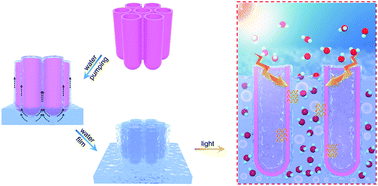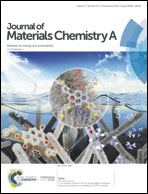A nanopump for low-temperature and efficient solar water evaporation†
Abstract
Water evaporation is a ubiquitous phenomenon in nature and the essential component of the water cycle on the earth. A high evaporation rate is required for application in desalination and sterilization, but remains a great challenge at a relatively low temperature under solar irradiation. In this study, free-standing membranes of highly ordered nanotube arrays are synthesized by anodizing the Zr–30Ti alloy. The vertical tubular structure provides three-dimensional channels for water transportation, and the superhydrophilic nature provides capillary force for continuous water pumping. This forms a three-dimensional and vertical alignment of ultrathin water films at the nanoscale (an inverse structure of nanotube arrays); in this scenario, the large interfacial contact between tube walls and the water film results in efficient heat transfer and mass transport, thus facilitating water evaporation. The use of the Zr–30Ti alloy produces ZrO2 nanotubes where some of the Zr ions are substituted by Ti counterparts. This incorporates a large number of oxygen vacancies by lowering its formation energy and extends light absorption up to 1600 nm. The Zr(Ti)O2 nanotube membranes with superhydrophilic vertical channels and strong light absorption function as a nanopump for solar water evaporation, with an evaporation rate of 1.64 kg m−2 h−1 under 1 sun irradiation at 20.5 °C, which is much higher than the state-of-the-art reports employing metal compounds.



 Please wait while we load your content...
Please wait while we load your content...